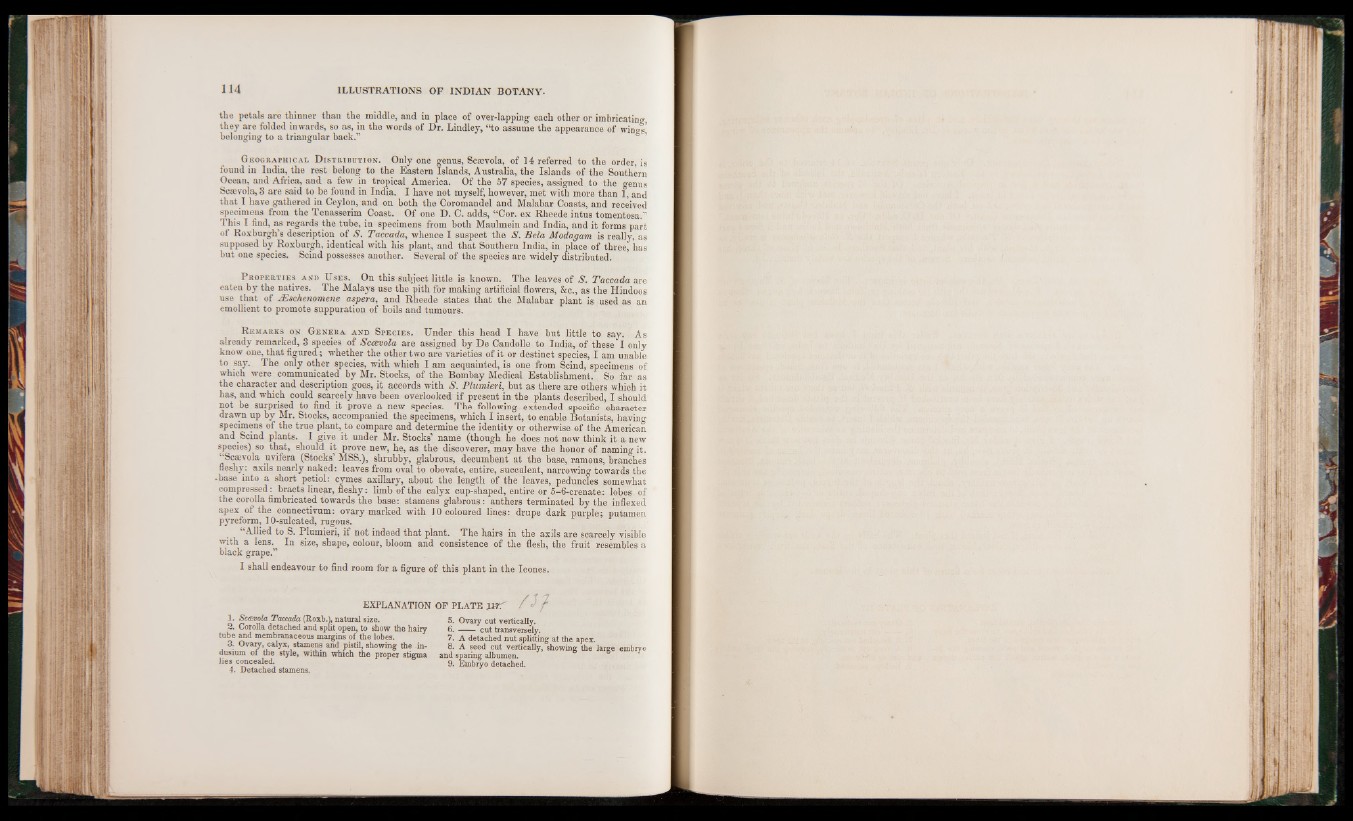
the petals are thinner than the middle, and in place of over-lapping each other or imbricating
they are folded inwards, so as, in the words of Dr. Lindley, “to assume the appearance of wings
belonging to a triangular back.11
Geographical Distribution. Only one genus, Scsevola, of 14 referred to the order, is
found in India, the rest belong to the Eastern Islands, Australia, the Islands of the Southern
Ocean, and Africa, and a few in tropical America. Of the 57 species, assigned to the genus
Scagvola, 3 are said to be found in India. I have not myself, however, met with more than 1, and
that I have gathered in Ceylon, and on both the Coromandel and Malabar Coasts, and received
specimens from the Tenasserim Coast. Of one D. C. adds, “Cor. ex Rheede intus tomentosa.”
This I find, as regards the tube, in specimens from both Maulmein and India, and it forms part
of Roxburgh’s description of S. Taccada, whence I suspect the S. Bela Modagam is really, as
supposed by Roxburgh, identical with his plant, and that Southern India, in place of three, has
but one species. Scind possesses another. Several of the species are widely distributed.
P roperties and Uses. On this subject little is known. The leaves of S. Taccada are
eaten by the natives. The Malays use the pith for making artificial flowers, Sec., as the Hindoos
use that of JEschenomene as-pe-ra, and Rheede states that the Malabar plant is used as an
emollient to promote suppuration of boils and tumours.
Remarks on Genera and Species. Under this head I have but little to say. As
already remarked, 3 species of Sccevola are assigned by De Candolle to India, of these I only
know one, that figured; whether the other two are varieties of it or destinct species, I am unable
to say. The only other species, with which I am acquainted, is one from Scind, specimens of
which were communicated by Mr. Stocks, of the Bombay Medical Establishment. So far as
the character and description goes, it accords with S . Plumieri, but as there are others which it
has, and which could scarcely have been overlooked if present in the plants described, I should
not be surprised to find it prove a new species. The following- extended specific character
drawn up by Mr. Stocks, accompanied the specimens, which I insert, to enable Botanists, having
specimens of the true plant, to compare and determine the identity or otherwise of the American
and Scind plants. I give it under Mr. Stocks’ name (though he does not now think it a new
species) so that, should it prove new, he, as the discoverer, may have the honor of naming it.
“Scaevola uvifera (Stocks’ MSS.), shrubby, glabrous, decumbent at the base, ramous, branches
fleshy: axils nearly naked: leaves from oval to obovate, entire, succulent, narrowing towards the
-base into a short petiol: cymes axillary, about the length of the leaves, peduncles somewhat
compressed: bracts linear, fleshy: limb of the calyx cup-shaped, entire or 5- 6-crenate: lobes of
the corolla fimbricated towards the base: stamens glabrous: anthers terminated by the indexed
apex of the connectivum: ovary marked with JO coloured lines: drupe dark purple; putamen
pyreform, 10-sulcated, rugous.
“Allied to S. Plumieri, if not indeed that plant. The hairs in the axils are scarcely visible
with a lens. In size, shape, colour, bloom and consistence of the flesh, the fruit resembles a
black grape.”
I shall endeavour to find room for a figure of this plant in the leones.
EXPLANATION
1. Sccevola, Taccada (RoxbA natural size.
2. Corolla detached and split open, to show the hairy
tube and membranaceous margins of the lobes.
3. Ovary, calyx, stamens and pistil, showing the in-
dusium o f the style, within which the proper stigma
lies concealed.
4. Detached stamens.
o p p l a t e y ? r r / j ;
5. Ovary cut vertically.
6 . ---cut transversely.
7. A detached nut splitting at the apex.
8. A seed cut vertically, showing the large embryo
and sparing albumen.
9. Embryo detached.